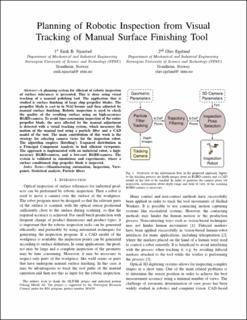| dc.contributor.author | Njåstad, Eirik Bjørndal | |
| dc.contributor.author | Egeland, Olav | |
| dc.date.accessioned | 2022-02-14T12:14:54Z | |
| dc.date.available | 2022-02-14T12:14:54Z | |
| dc.date.created | 2021-09-10T08:25:38Z | |
| dc.date.issued | 2019 | |
| dc.identifier.issn | 1051-4651 | |
| dc.identifier.uri | https://hdl.handle.net/11250/2978765 | |
| dc.description.abstract | A planning system for efficient of robotic inspection of surface tolerances is presented. This is done using visual tracking of a manual polishing tool. The application that is studied is surface finishing of large ship propeller blades. The propeller blade is cast in in NiAl bronze and then adjusted by manual surface finishing. Robotic inspection is used to check the quality of the resulting surface using an high-accuracy RGBD-camera. To avoid time-consuming inspection of the entire propeller blade, the area affected by the manual adjustment is detected with a visual tracking system, which measures the motion of the manual tool using a particle filter and a CAD model of the tool. The main contribution of this work is the strategy for selecting camera views for the inspection robot. The algorithm employs Hotelling's T-squared distribution in a Principal Component Analysis to find efficient viewpoints. The approach is implemented with an industrial robot, a high-accuracy RGBD-camera, and a low-cost RGBD-camera. The system is validated in simulations and experiments, where a surface conditioned ship propeller blade is inspected. | en_US |
| dc.language.iso | eng | en_US |
| dc.publisher | Institute of Electrical and Electronics Engineers (IEEE) | en_US |
| dc.title | Planning of robotic inspection from visual tracking of manual surface finishing tool. | en_US |
| dc.type | Peer reviewed | en_US |
| dc.type | Journal article | en_US |
| dc.description.version | acceptedVersion | en_US |
| dc.rights.holder | © IEEE. Personal use of this material is permitted. Permission from IEEE must be obtained for all other uses, in any current or future media, including reprinting/republishing this material for advertising or promotional purposes, creating new collective works, for resale or redistribution to servers or lists, or reuse of any copyrighted component of this work in other works. | en_US |
| dc.source.journal | IEEE Computer Society | en_US |
| dc.identifier.doi | 10.1109/IRC.2019.00052 | |
| dc.identifier.cristin | 1933041 | |
| dc.relation.project | Norges forskningsråd: 261639 | en_US |
| cristin.ispublished | true | |
| cristin.fulltext | postprint | |
| cristin.qualitycode | 0 | |
